Сыма Цянь. Исторические записки (Ши Цзи). Том 3
Подождите немного. Документ загружается.


Указатель терминов
и
должностей
чжунъюй
»f Ц 502, 602,
768,
782
чи-ди
ф> * 158
чэнцзян
*$ ^ 827
чэхоу
fa ^ 828
чэнс$ш
*& Щ 284, 288, 294,
319,
459, 826, 846
шандуйцзян
Jz. Щ^ Щ 548
шаньюй
f f 642, 643, 648,
670,
775, 780
шаофу
*у jfa 584
шуго
% @ 769
шужэнь
#
%
Л. 836
шуйвэй
#[#J % 522 *
шучжан
^ ^ 176, 234, 244,
256,
276, 282
шэжэнь
^ А. 454, 596
шэньту
Ф 44_ 462
юань-шоу
TL |J 790
юй 4t
288
юйлиньцзян
Щ fa Щ- 528
юйши
Щ jt 354, 686
юйши-дафу
#р 5t *. ^
47
0
юн ^ 824
юсыма
$j Щ
Л
Щ 516
юпзи-цзянцэюнъ
уЩ.
Щг
Щ
}
U*
476
ю-цзуй
.yjg |£, 29, 833
юэ $j
448
'
824
юэ-бяо
^ ^ 8
юэлин
4L А- 551.
яшэян
^ jjj. 486
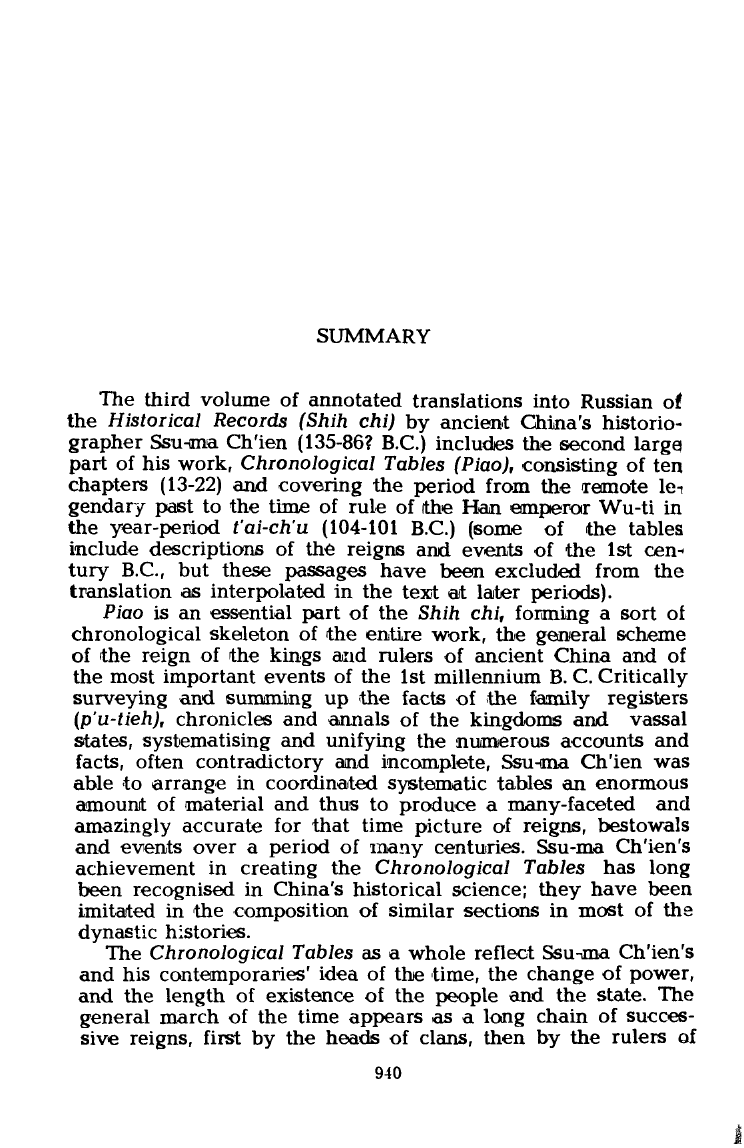
SUMMARY
The third volume of annotated translations into Russian oî
the Historical Records (Shih chi) by ancient China's historio-
grapher Ssu-ma Ch'ien (135-86? B.C.) includes the second large
part of his work, Chronological Tables (Piao), consisting of ten
chapters (13-22) and covering the period from the remote lei
gendary past to the time of rule of (the Han emperor Wu-ti in
the year-period t'ai-ch'u (104-101 B.C.) (some of the tables
include descriptions of the reigns and events of the 1st cen-
tury B.C., but these passages have been excluded from the
translation as interpolated in the text at later periods).
Piao is an essential part of the Shih chi, forming a sort of
chronological skeleton of the entire work, the general scheme
of the reign of the kings and rulers of ancient China and of
the most important events of the 1st millennium
В.
С Critically
surveying and summing up the facts of «the family registers
(p'u-tieh),
chronicles and annals of the kingdoms and vassal
states,
systematising and unifying the numerous accounts and
facts,
often contradictory and incomplete, Ssunma Ch'ien was
able to arrange in coordinated systematic tables an enormous
amount of material and thus to produce a many-faceted and
amazingly accurate for that time picture of reigns, bestowals
and events over a period of many centuries. Ssu-ma Ch'ien's
achievement in creating the Chronological Tables has long
been recognised in China's historical science; they have been
imitated in the composition of similar sections in most of the
dynastic histories.
The Chronological Tables as a whole reflect Ssu-тта Ch'ien's
and his contemporaries' idea of the time, the change of power,
and the length of existence of the people and the state. The
general march of the time appears as a long chain of succes-
sive reigns, first by the heads of clans, then by the rulers of
940
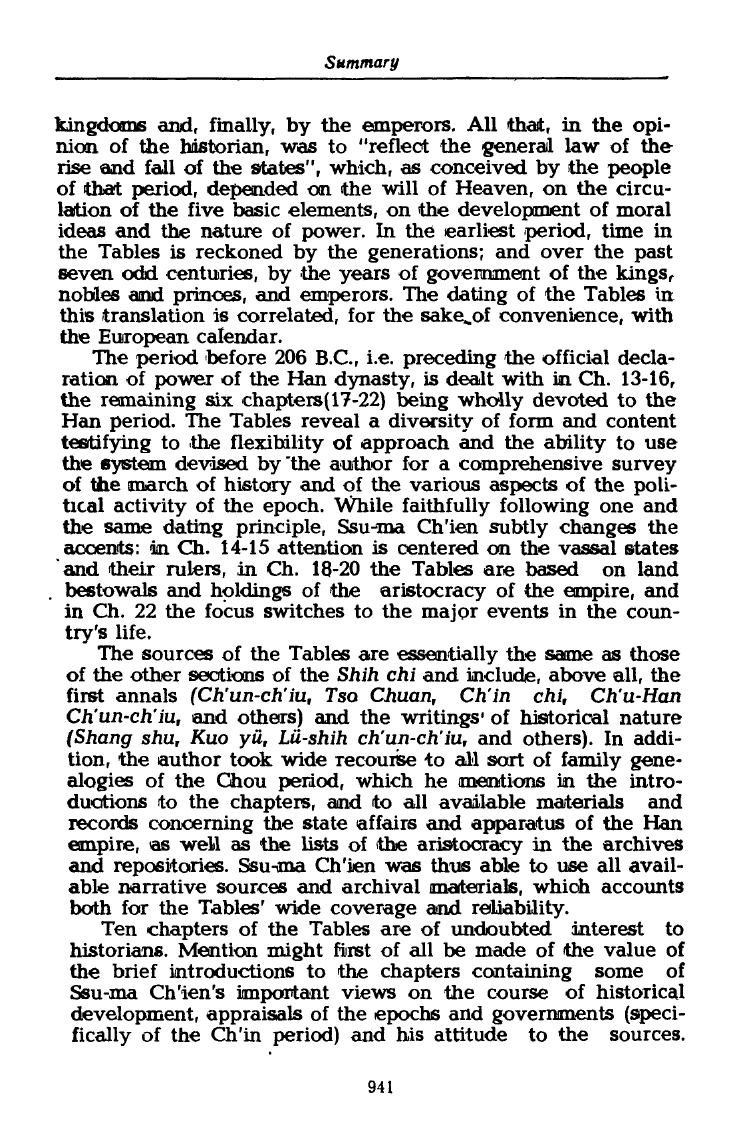
Summary
kingdoms and, finally, by the emperors. All that, in the opi-
nion of the historian, was to "reflect the general law of the
rise and fall of the states", which, as conceived by the people
of that period, depended on the will of Heaven, on the circu-
lation of the five basic elements, on the development of moral
ideas and the nature of power. In the earliest period, time in
the Tables is reckoned by the generations; and over the past
seven odd centuries, by the years of government of the kings
r
nobles and princes, and emperors. The dating of the Tables in
this translation is correlated, for the sake^of convenience, with
the European calendar.
The period before 206 B.C., i.e. preceding the official decla-
ration of power of the Han dynasty, is dealt with in. Ch. 13-16,
the remaining six chapters(17-22) being wholly devoted to the
Han period. The Tables reveal a diversity of form and content
testifying to the flexibility of approach and the ability to use
the system devised by "the author for a comprehensive survey
of the march of history and of the various aspects of the poli-
tical activity of the epoch. While faithfully following one and
the same dating principle, Ssu-ma Ch'ien subtly changes the
accents: in Ch. 14-15 attention is centered on the vassal states
and their rulers, in Ch. 18-20 the Tables are based on land
bestowals and holdings of the aristocracy of the empire, and
in Ch. 22 the focus switches to the major events in the coun-
try's life.
The sources of the Tables are essentially the same as those
of the other sections of the Shih chi and include, above all, the
first annals (Ch'un-ch'iu, Tso Chuan, Ch'in chi, Ch'u-Han
Ch'un-ch'iu, and others) and the writings' of historical nature
(Shang shu, Kuo yü, Lü-shih ch'un-ch'iu, and others). In addi-
tion, the author took wide recourse to all sort of family gene-
alogies of the Chou period, which he mentions in the intro-
ductions to the chapters, and to all available materials and
records concerning the state affairs and apparatus of the Han
empire, as well as the lists of the aristocracy in the archives
and repositories. Ssu-ma Ch'ien was thus able to use all avail-
able narrative sources and archival materials, which accounts
both for the Tables' wide coverage and reliability.
Ten chapters of the Tables are of undoubted interest to
historians. Mention might first of ali be made of the value of
the brief introductions to the chapters containing some of
Ssu-ma Ch'ien's important views on the course of historical
development, appraisals of the epochs and governments (speci-
fically of the Ch'in period) and his attitude to the sources.
941
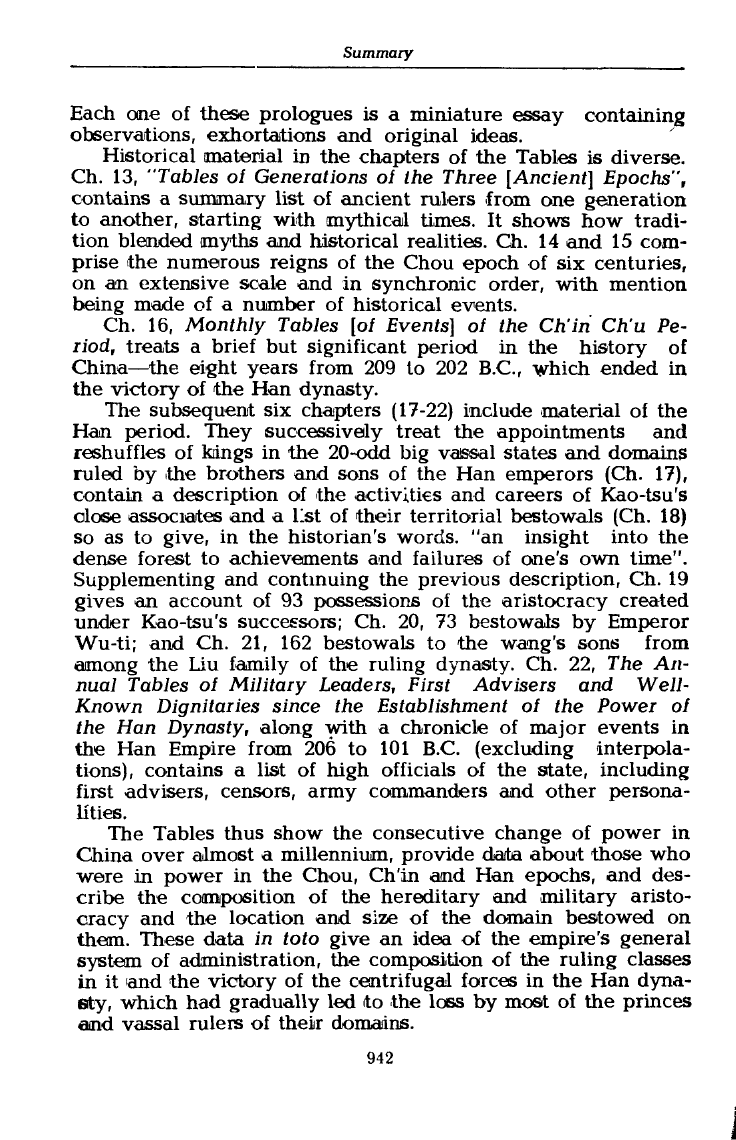
Summary
Each one of these prologues is a miniature essay containing
observations, exhortations and original ideas.
Historical material in the chapters of the Tables is diverse.
Ch. 13, "Tables of Generations of the Three [Ancient] Epochs",
contains a summary list of ancient rulers from one generation
to another, starting with mythical times. It shows how tradi-
tion blended myths and historical realities. Ch. 14 and 15 com-
prise the numerous reigns of the Chou epoch of six centuries,
on an extensive scale and in synchronic order, with mention
being made of a number of historical events.
Ch. 16, Monthly Tables [of Events] of the Chin Ch'u Pe-
riod,
treats a brief but significant period in the history of
China—the eight years from 209 to 202 B.C., which ended in
the victory of the Han dynasty.
The subsequent six chapters (17-22) include material of the
Han period. They successively treat the appointments and
reshuffles of kings in the 20-odd big vassal states and domains
ruled by the brothers and sons of the Han emperors (Ch. 17),
contain a description of the activities and careers of Kao-tsu's
close associates and a list of their territorial bestowals (Ch. 18)
so as to give, in the historian's words, "an insight into the
dense forest to achievements and failures of one's own time".
Supplementing and continuing the previous description, Ch. 19
gives an account of 93 possessions of the aristocracy created
under Kao-tsu's successors; Ch. 20, 73 bestowals by Emperor
Wu-ti; and Ch. 21, 162 bestowals to the wang's sons from
among the Liu family of the ruling dynasty. Ch. 22, The An-
nual Tables of Military Leaders, First Advisers and Well-
Known Dignitaries since the Establishment of the Power of
the Han Dynasty, along with a chronicle of major events in
the Han Empire from 206 to 101 B.C. (excluding interpola-
tions),
contains a list of high officials of the state, including
first advisers, censors, army commanders and other persona-
lities.
The Tables thus show the consecutive change of power in
China over almost a millennium, provide data about those who
were in power in the Chou, Ch'iri and Han epochs, and des-
cribe; the composition of the hereditary and military aristo-
cracy and the location and size of the domain bestowed on
them. These data in toto give an idea of the empire's general
system of administration, the composition of the ruling classes
in it and the victory of the centrifugal forces in the Han dyna-
sty, which had gradually led to the loss by most of the princes
and vassal rulers of their domains.
942
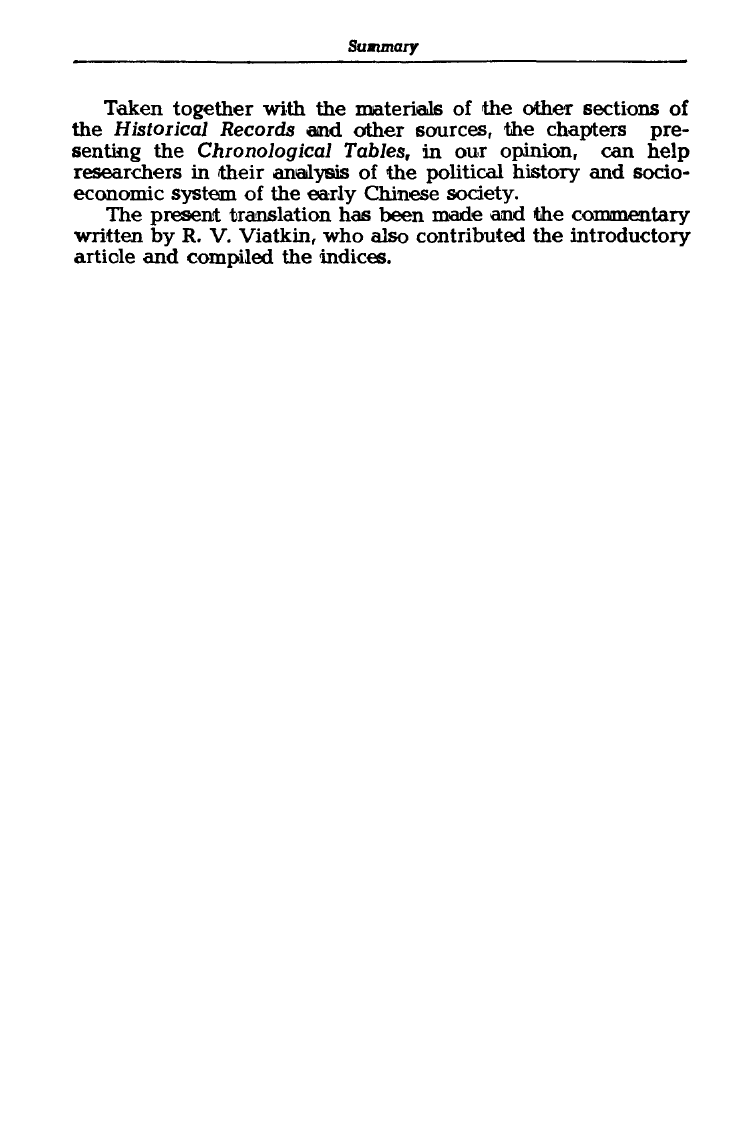
Summary
Taken together with the materials of the other sections of
the Historical Records and other sources, the chapters pre-
senting the Chronological Tables, in our opinion, can help
researchers in their analysis of the political history and socio-
economic system of the early Chinese society.
The present translation has been made and the commentary
written by R. V. Viatkin, who also contributed the introductory
article and compiled the indices.
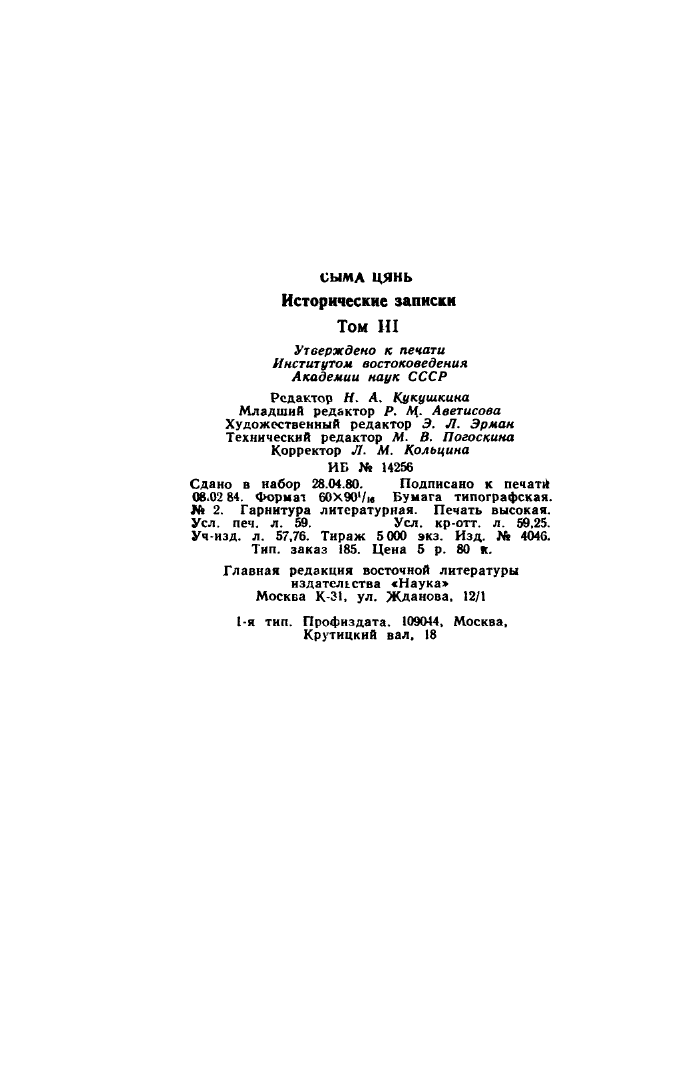
СЫМА ЦЯНЬ
Исторические записки
Том Ш
Утверждено к печати
Институтом востоковедения
Академии наук СССР
Редактор Н. Л. Кукушкина
Младший редактор Р. Ц. Аветисова
Художественный редактор Э. Л. Эрман
Технический редактор М. В. Погоскина
Корректор Л. М. Кольцина
ИБ № 14256
Сдано в набор 28.04.80. Подписано к печати
08.02 84. Форнат 60X90'/.« Бумага типографская.
M 2. Гарнитура литературная. Печать высокая.
Усл.
печ. л. 59. Усл. кр-отт. л. 59,25.
Уч-изд. л. 57,76. Тираж 5000 экз. Изд. № 4046.
Тип.
заказ 185. Цена 5 р. 80 к.
Главная редакция восточной литературы
издательства' «Наука»
Москва К-31, ул. Жданова, 12/1
1-я тип. Профиздата. 109044, Москва,
Крутицкий вал, 18.

Опечатки и исправления
Стр.
836
861
865
866
879
883
898
937
937
, Строка
30 сн.
16 св.,
лев.
кол.
2 сн.,
лев.
кол.
17 св.,
лев.
кол.
7 св.,
лев.
кол.
9 св.,
прав.кол.
6 сн.,
лев.
кол.
9 сн.,
прав.кол.
4 сн.,
прав.кол.
Напечатано
хоу цзян-
цзюнь
Би Мэн
ÜÜ.
1*.
Гун-хоу
t ft
Гун-хоу
Следует читать
хоу-цяньцзюнь
Би Мэн
%»%-
Гун-хоу
Ш
it * 1*
Гун-хоу Хуэй
ХЭЙ
я Aft КИНЬ.
Мао Пань-
линь
Сюаньпин-
хоу
Цзянъи-хоу
Чжао Яо
ЛЫ*.
фоудуцзянь
%£?
хоу-цзян-
цзюнь
Мао Пань-линь
Я*
*.
Сюаньпин-хоу
î*flL
Цзянъи-хоу
Чжао Яо
а Ы* « IL
фоудуцзюнь
«Jfcf
хоу-цяньцзюнь
Тип.
№ 3 изд-ва "Наука". Зак. 389-5000
